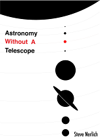Fabulous sights through a cheap telescope
Saturn
So you’ve spent anything up to $300 on a backyard science project and your friends and family are giving you sideways looks? Just set your scope on Saturn. One look and they’ll be out shopping for their own cheap telescope.
The rings are nearly always visible, except maybe when they are aligned exactly side on to the earth. This is going to happen in 2009, theInternational Year of Astronomy.
 To find planets go here. More background information on Saturn is here.
To find planets go here. More background information on Saturn is here.
Jupiter
A close second to Saturn, a cheap telescope will show you the planet with the faintest hint of colour bands, as well up to four of theGalilean moons. Fabulous.
 To find planets go here. More background information on Jupiter is here.
To find planets go here. More background information on Jupiter is here.
The Orion Nebula
Part of the Orion constellation—and specifically Orion’s Belt—the nebula is one of the brightest and probably the easiest one to find. However, it’s only up in the late evening southern skies around summer and autumn.
The nebula is the middle star of the dagger that hangs off Orion’s Belt—or, if you prefer, the middle star of the handle of the Saucepan. This ‘star’ looks fuzzy even through binoculars—and through a cheap telescope you see a faint whitish haze that fills most of your field of view and a collection of real stars inside it. This is a stellar nursery complete with baby stars.
 To find Orion’s Belt, go here. More background information on the Orion Nebula is here.
To find Orion’s Belt, go here. More background information on the Orion Nebula is here.
The Carinae Nebula
The Carinae Nebula is in the vicinity of the Southern Cross, so has the advantage of being visible throughout the year, although it gets lower in the late evening southern skies of summer—and is hence more difficult to see. Fortunately, the Orion Nebula is easy to see in summer.
 For directions to the Carinae Nebula go here. More background information is here.
For directions to the Carinae Nebula go here. More background information is here.
Alpha Centauri
A cheap telescope is quite adequate to reveal that our closest stellar neighbour is actually a system of two bright stars, Alpha Centauri A and B. All you see is one dot magnified into two dots, but it is interesting enough to try once. There is also a third member of the system, a red dwarf called Proxima Centauri, which you won’t see.
 For directions to Alpha Centauri go here. More background information is here.
For directions to Alpha Centauri go here. More background information is here.
The Moon
Definitely the easiest object to find in the night skies (when it’s up) and a good reference point to align (or realign) your finder scope with your main scope. Seeing individual craters at the shadowy edge of a waxing or waning moon is arguably more exciting than the lit-up full moon—but it’s an arresting view at any time.
 No directions needed! More background information is here.
No directions needed! More background information is here.
The Jewel Box
The Jewel Box (or Kappa Crucis cluster) lies close to the Southern Cross (see here). Its reputedly colourful appearance is a result of the orange Kappa Crucis star (a red supergiant) lying in the midst of other blue and white stars.
For directions to the Jewel Box go here. More background information is here.
Kappa Crucis is a good example of the maxim that big stars live fast and die young. The whole cluster is only around 7 million years old, but in contrast to its young blue neighbours, Kappa Crucis has already burned through to red giant phase due its initial large mass. The cluster also proves another maxim—all blue stars are young, but not all young stars are blue. Blue means a star is very hot—which is often a sign of relative youth—but the length of a star’s life is mostly about how much mass it starts off with. Our modest white Sun is already 5 billion years old and has another 5 billion years before it goes red giant. It was probably never blue.




